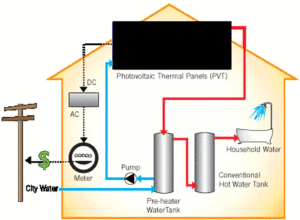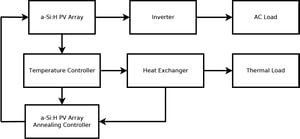Photovoltaic solar thermal

Photovoltaic solar thermal (PVT) hybrid systems purpose is to produce both heat and electricity in a smaller area than if you were to have both a photovoltaic panel and a solar thermal system. The current design for PVT is to have a solar panel glued to a solar thermal system. PVTs purpose is to use the solar thermal system to cool the photovoltaic cells to perform better, as solar cells degrade with temperatures greater than 25C. This means however, that the thermal aspect of the PVT has a significantly lower efficiency compared to just a solar thermal system (max 50% eff compared to 70+% eff).
Types[edit | edit source]
There are many different PVT designs:
- Air cooled or water cooled
- Integration of PV into the absorber or transparent cover
However, all focus on ways of improving the heat transfer between the solar cells and the coolant to lower the cells temperature. The most common design is the flat plate single pass PVT. This design has the solar cell and a duct which allows air to flow beneath the panel. Other designs include using water, double pass, concentrators, building integrated and adding fins.
Assessing PVT solutions may include the inclination of the installation and the heat demand over the year. In most cases it would be desirable to control the share of solar energy going into PV and into the therma system.
Amorphous silicon PVT[edit | edit source]

The concept of a photovoltaic solar thermal hybrid (PVT) has been around for over 30 years. However, due to the low efficiencies of the photovoltaic solar cell, PV/T were not economically feasible. In the past decade, PV/T has started to grow and this can be seen with the International Energy Association (IEA) Task 35 which is specifically on PV/T.[1]
The idea behind a PV/T system is to cool the photovoltaic (PV) solar panel with a coolant, usually water or air, and then use the excess heat to be used to heat up a water tank or a preheat for a house. It should be noted that photovoltaic solar cell output decreases with an increase in cell temperature above STC of 25 C.[2] For this reason a PV/T is quite interesting because it will allow an increase in the photovoltaic cell efficiency as well as use the heat emitted from the cell. It should be also noted that the absorber of a solar thermal system likes to be hot since the greater the temperature difference from the coolant and the absorber, the greater the heat transfer. So the design of an optimized PV/T is non-trivial.
Typically, in a PV/T system the absorber is the PV which causes a problem since the PV cells like to be cool and the absorber like to be hot. In the current literature, the design is to cool the PV as much as possible and neglect improving the efficiency of the solar thermal collection part of the PV/T system.[3] In this research project a PV cell is being designed that works better when it is hot to therefore optimize both the PV and thermal parts of a PV/T system.
The PV material of choice is amorphous silicon and this is due to its properties. Firstly amorphous silicon suffers from the Staebler-Wronski Effect (SWE). When amorphous silicon is exposed to sunlight, a greater number a recombinations are formed which causes a higher defect density which is known as the SWE. This lowers the efficiency of the cells. The thicker the material the greater the probability of recombination which is the reason amorphous silicon cell is only 200-500 nm thick. However, if you anneal the cells to 150 C for 4 hours you can return the cell efficiency to its initial state. The cells anneal very slowly at 25 C.[4] Amorphous silicon, like all cells' efficiency degrades with temperature, but amorphous silicon only degrades at 0.1%/C which is lower than most other cells. This makes a prime option for PVT.
See also[edit | edit source]
For literature reviews on PVT:
- Optimizing limited solar roof access by exergy analysis of solar thermal, photovoltaic, and hybrid photovoltaic thermal systems/Literature review
- PVT dispatch strategy literature review
For papers on PVT:
- High-temperature annealing pulses in amorphous silicon PVT
- Optimizing limited solar roof access by exergy analysis of solar thermal, photovoltaic, and hybrid photovoltaic thermal systems
- The effects of dispatch strategy on electrical performance of amorphous silicon-based solar photovoltaic-thermal systems
References[edit | edit source]
- ↑ IEA SHC Task 35 "PV/Thermal Solar Systems". http://www.pv-t.org/
- ↑ T.T. Chow. Applied Energy 87 (2010) 365–379
- ↑ S.C. Solanki et al. Applied Energy 86 (2009) 2421–2428.
- ↑ M. Shima et al. Solar Energy Materials & Solar Cells 85 (2005) 167–175